Aphids on Plants: Effective Ways to Kill Aphids on Indoor and Outdoor Plants
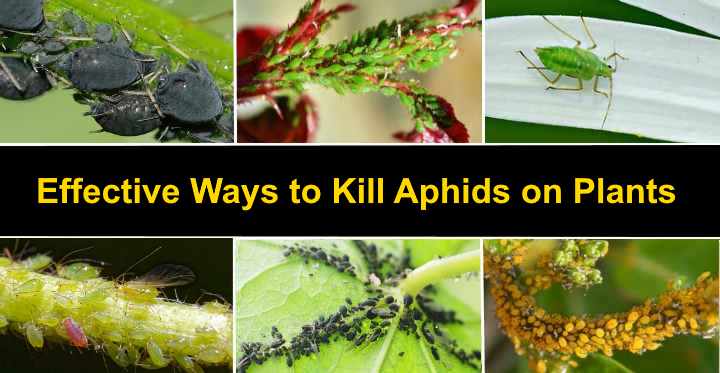
Aphids are tiny insects that suck sap from indoor and outdoor plants, causing a lot of damage. Aphids are crawling insects that generally lurk under plant leaves. In high numbers, aphids develop wings, hence their name greenfly or blackfly. Getting rid of aphids on plants fast is a top priority if you notice these pests on your plants.
Aphids are highly destructive plant pests. The damage they cause to plants includes stunted growth, wilted or crinkled foliage, and leaf drop. If an aphid infestation gets too large, the tiny insects can end up killing the plant. Aphids also secrete a sticky liquid called honeydew that causes black sooty mold to grow.
Aphids are a species of insects in the superfamily Aphiodiodea. There are over 5,000 species of aphids known to attack crops, outdoor garden plants, and houseplants. Depending on the species of aphid, they can measure between 2 and 3 mm long.
This article is a comprehensive guide to getting rid of aphid infestations on plants. You will find out ways of controlling aphids on indoor plants and in your garden. Additionally, you’ll learn about the life cycle of aphids to help prevent infestations.
What do Aphids Look Like?

Aphids on plants look like tiny crawling insects with various colors depending on the species, with some developing waxy or wooly coating
Aphids look like tiny pear-shaped insects crawling on plant stems and leaves. Depending on the species and what they feed on, these tiny bugs can be green, black, brown, white, pink, yellow or gray. Looking closely at pictures of aphids, you’ll notice they have long legs, antennae, and protruding cornicles at their rear end.
Researchers from the University of California say that some species of aphids (such as woolly aphids) develop a waxy or wooly appearance. This coating gives these species a fuzzy or shiny look. (1)
Aphids on their own are difficult to notice. Their pear-like bodies are less than 1/4 inch (6 mm), but most species are much smaller—around 2-3 mm. Some types of aphids may be as tiny as 1 mm long. Because aphids tend to feed in clusters, noticing a large infestation is not tricky.
Aphid nymphs look like smaller versions of the adults. Their almost translucent bodies are not as elongated as mature aphids. But if you look closely at infested plants, you will see the baby aphids feeding alongside the adults.
Some species of aphids grow wings. In large colonies, the winged insects fly to other plants to start feeding on those. Sometimes winged aphids are called greenfly or blackfly. White flying aphids can also be called whitefly—but they are not a true type of whitefly. Due to their similar appearance to lice, aphids also have the name “plant lice.”
Aphids Life Cycle
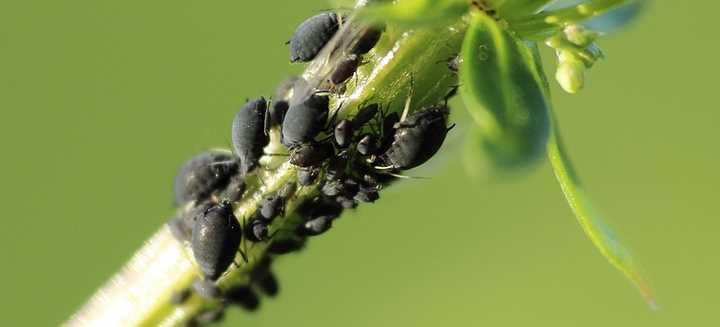
The life cycle of an aphid starts from an egg or a live nymph, depending on the aphid species
The life cycle of aphids is composed of the egg, the nymphal stages and the adult. The nymphs molt several times before becoming adults in about a week. Some female aphids give birth to live offspring and can produce up to 80 aphids in a week. (2) So, very quickly, aphids can infest a whole plant.
Aphid eggs live through the winter attached to the underside of leaves. The nymphs hatch in spring and rapidly reproduce. Female aphids can produce eggs asexually—meaning they don’t need to mate with a male.
During the spring and summer, aphids produce live nymphs. Then in the fall, males mate with females that lay eggs on the underside of leaves. Thus, new generations of aphids lie in wait to begin their attack on plants the following spring.
Understanding the life cycle of aphids is crucial to eradicating them. During the seasons when aphids are most active, regular pest control methods are necessary to stop the females from multiplying. During the winter dormant season, applying horticultural oils can help remove and kill aphid eggs.
Where do Aphids Come From?
Aphids come from the place they’ve been overwintering, usually the underside of leaves or crevices in plant stems. Aphids also come into homes in contaminated soil, on newly-bought houseplants, or flying aphids come in through open windows.
Because aphids are so tiny, they can hitch a ride into your house on new plants. So, always inspect houseplants you bring into your home. Check the leaves for eggs. Also, look closely at all parts of the plants for tiny crawling aphids.
Aphids can lay eggs in the soil, from where they emerge in the spring. So you may need to repot new houseplants in a sterile potting mix. Dispose of the old soil in case any eggs are lurking there. Replacing the potting mix can help ensure that aphids don’t come into your house that way.
How to Identify Aphids on Houseplants and Outdoor Plants
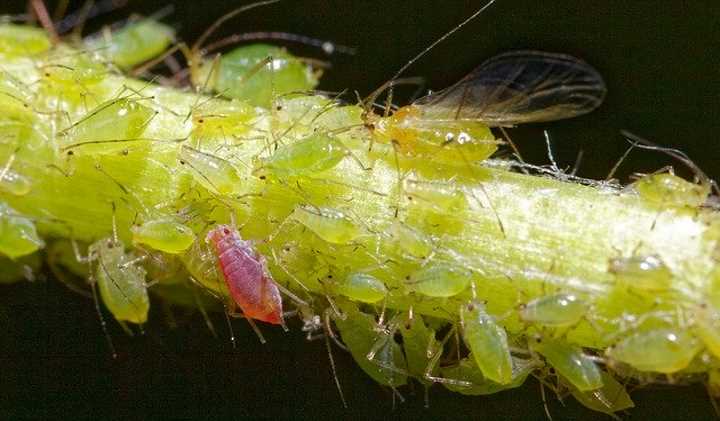
Identifying aphids on plants is done by seeing a mass of tiny insects on leaves or stems or noticing damage to the plant caused by aphid infestation
You can identify aphids either by looking for the tiny pest insects or observing plant damage. You can identify aphid infestation by looking for small pear-shaped insects in small colonies on the underside of leaves. You may also notice a honeydew substance on plants or misshapen, curling leaves.
If you have a significant infestation, it’s not difficult to identify the sap-sucking pests. You will see various sizes of tiny insects en masse on plant foliage. But you may need a magnifying lens to spot individual aphids under leaves.
The identifying features of aphids to look for are:
- Minuscule pear-shaped bugs with long legs that may look like a grasshopper from the side
- Two protruding tube-like structures from their hind
- Slender insects that can be green, black, pink, white, gray, yellow or brown
- Some aphids have wings, and some have a wooly or waxy coating
You can also spot the signs of an aphid infestation by the damage they do to plants. For example, many houseplant pests, including aphids, excrete a sticky substance on leaves and stems. If your plants are sticky and you see some tiny bugs crawling over them, it’s a sign you’ve got aphids.
It’s good to remember that honeydew, sooty mold, and increased ant activity also identify features of other pest infestations. So, it’s essential to also look for signs of scale insects or mealybug damage.
Aphid Damage to Plants
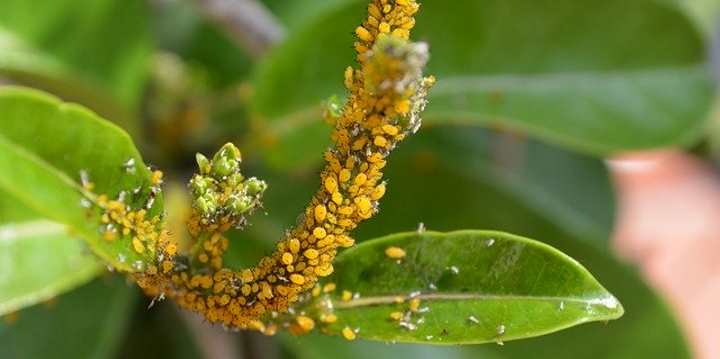
Aphid infestation can damage plant growth and weaken it, and in severe cases can cause the plant to die
Aphids cause widespread damage to plants. Aphid damage to plants include yellow crinkled leaves, and stunted growth that leave the plant looking disheveled. As the plant pests feed on the plant’s juices, the plant continues to lose nutrients. The result can be that the plant dies.
A few aphids on a healthy plant rarely result in much damage. But if you leave an aphid population to grow, the large number of sap-sucking pests will weaken your plant, making it susceptible to several other problems. Of course, aphids will quickly move to other plants, causing them damage as well.
Here are signs of plant damage that aphids can cause:
- Yellowing leaves—The leaves are usually the first part of the plant to suffer when aphids attack. Sucking nutrients from the plant starves the leaves. The lack of nutrients causes leaves to lose their color, dry up, and drop off prematurely.
- Curling leaves—Another damaging aspect of some aphids is that they inject toxins into plant tissue. This poisonous substance causes plant leaves to curl.
- Honeydew—While not damaging to plants, honeydew can attract other insects that damage the plants. Honeydew also attracts ants that in turn protect the aphids from predators, such as ladybugs and lacewings.
- Black sooty mold—This dark-colored fungus grows where honeydew is present. When it covers leaves, the black mold interferes with photosynthesis. If the plant doesn’t get enough light, it can’t get food that it needs to stay healthy.
- Gall formations—Some species of aphids cause plant damage in the way of galls. These are unusual growths on leaves, twigs, roots, or flowers. While not lethal to plants, they are unsightly.
How to Get Rid of Aphids on Plants
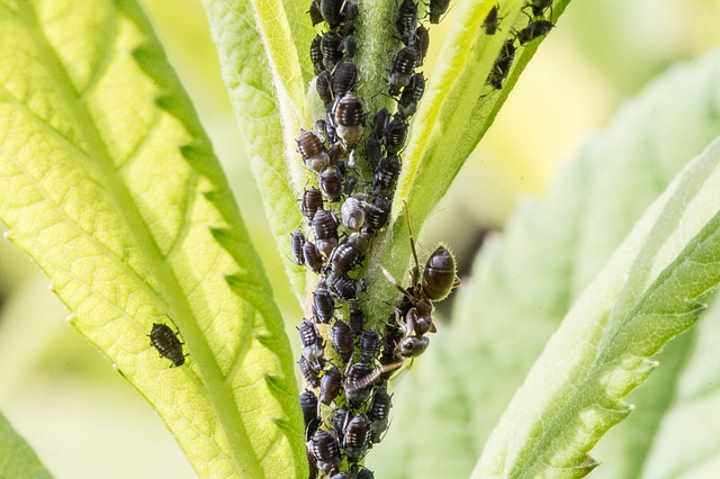
To get rid of aphids on infested plant, isolate the plant and use aphid control methods such as neem oil spray or soap spray
The first step in getting rid of aphids on houseplants is to remove and isolate the infested plant. The second step in eradicating the tiny pests is to use natural aphid control methods such as washing and spraying the plants.
Quick action is vital at the first sign of aphids. Aphids quickly reproduce and can become unmanageable.
It’s best to avoid using synthetic pesticides to get rid of aphids. Apart from killing off beneficial insects, many pesticides are toxic and not safe around humans or pets. Also, using chemical insecticides on aphid-infested vegetables or fruit trees can pollute the food chain.
Isolate and Prune Plants to Control Aphid Infestation
Isolate infested plants from other houseplants to prevent further infestation. Once isolated, check the stems and leaves for plant damage. Prune the foliage that is heavily infested and discard the contaminated plant parts in the trash. While in isolation, treat the plant with natural aphid treatments.
As well as checking the underside of leaves for aphids, look for activity around the base of the stems. Some aphids are active in the soil, and it may be a good idea to repot the plant as well using a sterile potting mix.
Wash Plants to Get Rid of Aphids on Indoor and Outdoor Plants
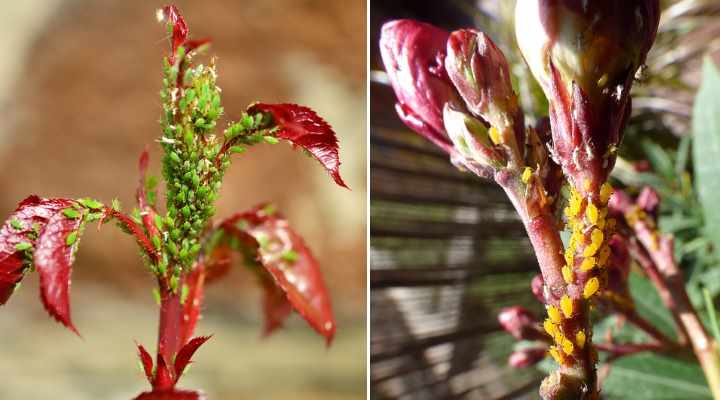
Washing your infested plant is an easy way to get rid of aphids on outdoor and indoor plants
You can remove most aphids from plants with a strong jet of water. Take the infested plant to the bathroom and turn the shower on the foliage to get rid of the aphids. The force of water should dislodge the majority of aphids and their nymphs.
If your houseplant has delicate foliage, remove aphids by dipping the plant in a bucket of clean water.
Use your garden hose to get rid of aphids on outdoor plants. Use the most forceful water pressure that displaces aphids but doesn’t harm foliage. Thoroughly douse the plants with water, ensuring to blast aphids from the underside of leaves.
Spray with Neem Oil to Kill Aphids on Houseplants
Neem oil is an effective organic treatment to get rid of aphids. Make a spray to kill aphids by adding 2 teaspoons neem oil, 1 teaspoon of Castile soap, and 1 quart (1 l) of lukewarm water to a spray bottle. Spray your plant liberally to control an aphid infestation.
Neem oil helps to kill most types of houseplant pests, including aphids, because it disrupts their reproductive system. Due to the life cycle of aphids, regular applications of neem oil are necessary to remove aphids permanently. Neem oil aphid sprays also have a residual effect. So, they will continue to affect aphids after application.
Neem oil is a type of horticultural oil that is useful in organic gardening. You can safely spray neem oil solutions on flowering plants such as roses to get rid of aphids, as well as on edible plants such as peppers and tomatoes. The benefit of neem oil is that it’s a natural pesticide that doesn’t harm beneficial insects.
Make a Homemade Soap Spray to Eradicate Aphids on Plants

Make aphid killing spray by mixing liquid dish soap and water and spray it on the affected plant
Use a homemade soap spray to kill aphids. Combine 1-2 teaspoons of liquid dish soap or Castile soap with 1 quart (1 l) of lukewarm water in a spray bottle and shake well. Spray all over the plant, and target aphid colonies to get rid of aphids permanently.
You can also use a soapy solution to get rid of aphids by applying it with a sponge. Dip a sponge is the soapy solution. Gently wipe both sides of the leaves to remove aphids and any eggs.
After you have applied the natural bug killing soap, leave it to dry for up to two hours. Then, using clean water, rinse the soap residue off the leaves to prevent any leaf damage.
Everyday liquid dish soap works effectively as an aphid control because it smothers the little critters. The fatty acids of the natural liquid soap break down their soft bodies and the tiny insects suffocate and die.
Apply Rubbing Alcohol to Kill Aphids on Contact
Isopropyl alcohol kills all types of aphids instantly. Dip a cotton swab in 70% rubbing alcohol and apply directly to crawling aphids. To control larger infestations, pour some rubbing alcohol on a damp cloth and wipe down infested leaves to get rid of lots of aphids at once.
You can also spray an alcohol solution to control aphids on foliage. Dilute 1 cup of alcohol with 1 quart (1 l) of water in a spray bottle. Spray liberally on the underside of leaves to get rid of greenfly and aphids. Use weekly until the pesky plant pests have gone for good.
To remove aphid eggs during the dormant stage in winter, you can use a cloth soaked in the diluted alcohol solution to wipe leaves. The alcohol kills eggs on contact to prevent them from hatching in the spring.
Alcohol helps eliminate many household pests, including aphids, because it breaks down the insects’ outer layer.
Epsom Salt to Get Rid of Aphids Naturally
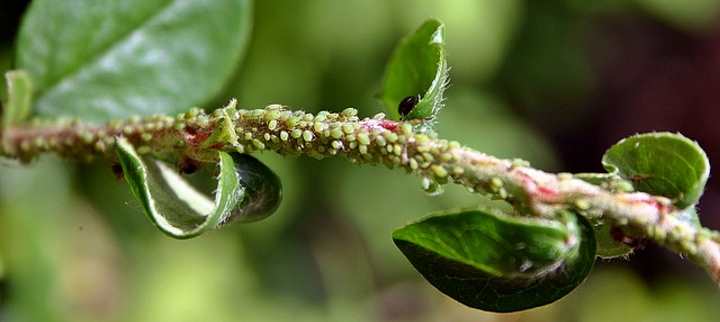
Epsom salt spray is an organic aphid treatment to get rid of aphids
Epsom salt can help you get rid of aphids without toxic chemicals. Make an aphid spray by filling a spray bottle with 1 gallon (3.8 liter) of water and adding 2 tablespoons of Epsom salt and 1-2 teaspoons of Castile soap. Shake well and spray your plants well to kill aphids.
When using the Epsom salt aphid treatment for controlling pests on outdoor plants, apply it in the late evening. Then the next morning, wipe the residue off the leaves to prevent leaf scorching. This aphid treatment is suitable for ornamental plants such as roses, and edible plants such as tomatoes and peppers.
It is believed that Epsom salt aphid spray kills them on contact as well as deters new pests from coming.
Use Sticky Traps to Control Flying Aphid Insects Naturally
Aphids stick to sticky traps and stop infesting your plants. While the sticky traps don’t get rid of aphids crawling on plants, they control colonies of flying aphids. Use sticky traps to limit the spread of aphids while you use natural aphid treatments on your plants.
Diatomaceous Earth (DE) to Get Rid of Aphids on Plants

When sprinkling DE on aphid infested plant as an organic aphid control method, the foliage must be dry for the treatment to be effective
Kill aphids using non-toxic diatomaceous earth. Dust plant foliage on both sides with diatomaceous earth to get rid of aphids naturally. The natural white powder destroys the soft bodies of aphids and other houseplant pests. The bugs then dehydrate and die.
When using diatomaceous earth for aphid removal, remember that it’s only effective on dry plant foliage.
Although food grade diatomaceous earth is non-toxic to humans, it’s a fine powder. So, wear protective eye covering and mask when dusting plants with DE to control aphids.
Related: Common Houseplant Pests: Types, Identification, and Control
How to Prevent Aphids on Plants
It can be tricky to prevent aphids on houseplants or outdoor plants. Usually, the best way to avoid aphid damage on plants is to grow healthy, robust plants. Proper watering techniques and the appropriate fertilizer help make plants resistant to pests, including aphids.
There are some ways that you can avoid getting problems with aphids. Here are a few:
- Inspect new plants—Prevent bringing aphids into the house by checking any plant you bring inside. You should inspect plants you buy and houseplants that grow outdoors in the summer.
- Wipe plant foliage in winter—Try and get rid of aphid eggs in the dormant period by wiping plant leaves. Use a diluted alcohol solution or neem oil to remove aphid eggs from the underside of leaves.
- Beneficial insects—Use biological control to prevent aphid infestations in outdoor plants. Predatory insects such as ladybugs and lacewings feed on aphids and help control their population.
Discover how to get rid of bugs in houseplants (including identification and pictures).
Related articles:
